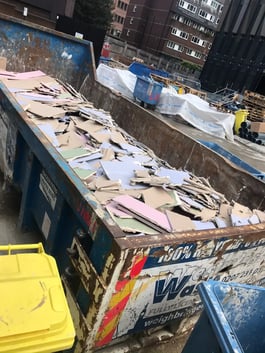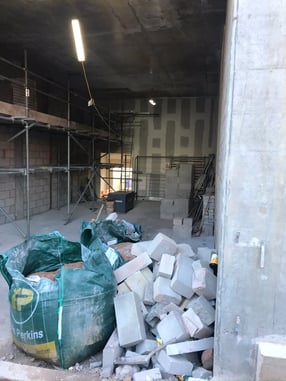Minimising waste is one of the most urgent considerations on any building development project. The sector through construction, demolition and excavation contributes as much as 62% of the UK’s total waste according to the Department for Environment, Food and Rural Affairs.
This makes waste reduction strategies and low-waste products more valuable and necessary than ever in the construction sector.
The makeup of internal walls is one of the main areas where material is wasted on a construction site. A survey from the Waste and Resource Action Program (WRAP) found that plasterboard can create wastage of between 10-35% on an average site through a combination of wasteful design, off-cuts, damage to the boards and over ordering.

This leads to an estimated 300,000 tonnes of plasterboard waste in the UK each year which is a huge problem, both at the initial extractive stage and the final disposal to landfill.
Every 1% of waste reduction you can find has a whole range of benefits:
- Reduction in labour moving waste to skips
- Reduced requirement for skips
- Less transport to landfill means fewer emissions
- Reduced time to bring waste to the skips
- Lowers cost of material disposal
- Lowers the amount of materials bought through over ordering
The above is why it is so important that architects, specifiers, developers and everyone else involved in a construction project needs to look at what they are using and find low-waste alternatives.
To stick with the plasterboard example, choosing a product like Specwall as an alternative material will yield a huge amount of benefit through the delivery, storage, installation, building life and reuse.
Specwall’s robust panel construction ensures less waste due to damage during transportation to the workface, and all off-cuts can be used on site rather than put into landfill.

Specwall panels use fewer components and more robust ancillaries in the heavy gauge track, deflection head and angle are less susceptible to damage. Less damage and a simpler overall system means there is a reduced number of replacement materials.
Specwall panels are bonded with brush and tube applied adhesives and fire mastics. No heave mixing or mortar deliveries. No grounds are required for door casings.
No additional lintels are needed for doorways or openings of up to 2,600mm when using Specwall panels. Likewise, no complicated letterbox details are required. You can cut the required pattress out and re-use the off cut during construction with minimal planning with less than 3% waste.
Similarly, Design changes, setting out errors can be easily rectified with minimal waste. Minor changes in location of builders works required 0% additional Specwall material.
Specwall panels are not damaged by water, and do not promote old growth, reducing replacement during construction and during the life of the building.
Should a change of use be required in the future, Specwall again provides major waste reduction benefits. All panels can be demounted, cut, moved and re-used to change floor plates as desired. No additional panels or fittings are needed and panels do not have to be discarded to landfill in the same way as plasterboard and blockwork.
Full floor reconfiguration can be achieved with 50% of materials salvaged, as documented in our BRE approved Environmental Product Declaration.
Finally, all Specwall systems are a minimum of two hour fire rated, and our A1 system is at least three and half hour fire rated. To learn more about the latest fire tests, please click here.
Choosing the right products is a key part of any waste reduction strategy, and Specwall is a fantastic option to help you save the planet, save time and save money. Get in touch with the team today to learn more by clicking here.



